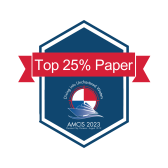Loading...
Paper Type
Complete
Description
The dissemination of fake news intensified during the COVID-19 pandemic. Thus, in this paper we propose a process-based model grounded on the diffusion of innovations theory to investigate how fake news was shared via social media. Accordingly, data was categorized according to the taxonomy of process, namely: input, output, players and activities. We found that individual decision-making traits, fake news perceived features and communication channel attributes are determinants of a personal attitude vis-à-vis a received fake news. The attitude then leads to the decision of whether or not to believe in the fake news, while confirmation conveys to the spread of same. In this way, social media, mediated by the power of algorithms and echo chambers, increase the chance of spreading misinformation.
Paper Number
1366
Recommended Citation
Lorenzo, Manuela Fortes; Marchi Machado, Luciano; SOARES, CARLA; and JOIA, LUIZ ANTONIO, "Fake News Diffusion: A Process-Based Approach" (2023). AMCIS 2023 Proceedings. 4.
https://aisel.aisnet.org/amcis2023/lacais/lacais/4
Fake News Diffusion: A Process-Based Approach
The dissemination of fake news intensified during the COVID-19 pandemic. Thus, in this paper we propose a process-based model grounded on the diffusion of innovations theory to investigate how fake news was shared via social media. Accordingly, data was categorized according to the taxonomy of process, namely: input, output, players and activities. We found that individual decision-making traits, fake news perceived features and communication channel attributes are determinants of a personal attitude vis-à-vis a received fake news. The attitude then leads to the decision of whether or not to believe in the fake news, while confirmation conveys to the spread of same. In this way, social media, mediated by the power of algorithms and echo chambers, increase the chance of spreading misinformation.
When commenting on articles, please be friendly, welcoming, respectful and abide by the AIS eLibrary Discussion Thread Code of Conduct posted here.




Comments
LACAIS Chapter